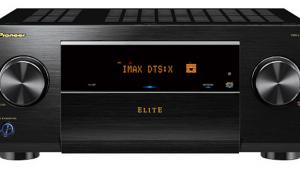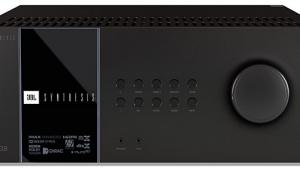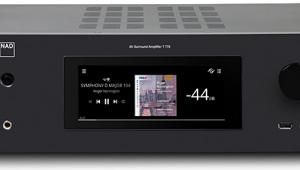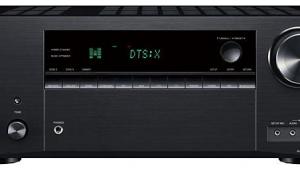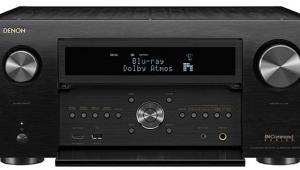Marantz CINEMA 50 AV Receiver Review Page 2
Listening
That scrutiny yielded more than satisfactory results. On two-channel "Direct" mode subwoofer-less music auditions via my modestly low-sensitivity stand-mount 3-ways, the Marantz revealed no shortfall whatsoever relative to my everyday 150-watts-per-channel power amplifier. A highly transparent track like "Jack of Speed," from the late (and largely forgettable) Steely Dan album Two Against Nature (Qobuz 96/24 stream) glistened with clarity, the snare's rim-strikes knifing through the air and the slightly brownish color and texture of the late Walter Becker's bass sound plainly evident. The Cinema 50's 110 watts (2-channel) proved ample to play even such demanding rock near control-room levels—certainly as loudly as I would ever ask.

Multichannel music may be a dwindling genre, but it's a unique test of, obviously, multichannel systems. I cued up a relative newcomer to my SACD shelf, Reference Recordings' edition of the Gustav Holst chestnut The Planets (Kansas City Symphony, Michael Stern), and was rewarded with broad and deep, sharply defined sound. (I judged this recording as being very slightly brighter than most RR productions, but not unpleasantly so.) The KC outfit's focused string ensemble was cleanly portrayed, and I was pleased to find that I only needed the tiniest adjustment of my subwoofer level (-1.5 dB) to bring the sound into what I considered ideal balance. For comparison, I replayed "Mars" and "Jupiter" with the system reconfigured subwoofer-less and thus driving my front speakers full-range; even without powered sub support, the Cinema 50 still had plenty of fortitude to deliver honest, mid-hall concert levels with no sign of strain.
Moving on to film sound, I streamed the new German remake of the anti-war epic All Quiet on the Western Front, which easily qualifies as a reference for sound design. With the Cinema 50 at quarterback, my mongrel-speakers 5.1.4 layout did a fine job of conveying the film's expansive sound design: the flat, in-your-face sound of the war in the trenches, the startling contrast of reverberant indoor ambiance from the brief scenes in the war offices, and of course the visceral impact of explosions, but also the surprising techno score. No complaints, even at real-cinema volume settings.
Returning to setup mode, recall that the Cinema 50 can integrate multiple subwoofers in its room-calibration system via Audyssey's XT32's Sub EQ HT. I re-ran the Marantz' Audyssey routine with a second subwoofer—one a bit less capable than my sub-25 Hz everyday unit, but still no slouch. The second woofer was located about two-thirds of the way along one of my studio's long walls. The result was interesting: Audyssey got the levels and crossover details bang-on again, and the resultant sound was, I felt, just a bit more even through the sub-to-system crossover region, yielding a just-perhaps tighter, or less blowzy sound on bass-heavy content like the track "Cousin Dupree" from the above-mentioned Steely Dan album.
Obviously, every room and multi-sub system will be dramatically different, but the advantages of implementing multiple subs to "spread out" the influence of room modes are pretty well established. Audyssey's XT32 aid, as I experienced in the Cinema 50, appears to work well in making the effective setup of such an upgrade relatively easy.
The Other Stuff
Generally, I found the Marantz receiver a pleasure to use once I sorted out the usual frustrations of HDMI-control conflicts among components, which was likely no fault of the Cinema 50. (As an aside, we need a clear, brand-independent industry standard here that allows the user to establish one component as the Ring of Power and the others to clearly confirm its hegemony. Yeah, I know that's how HDMI control is already supposed to work…) Marantz's on-screen menus are simple and to the point, while the receiver remote's "Info" key pops up all the data regarding audio and video modes and technical particulars you'd want to see.

That remote is an elegantly slim design, well laid out with crisp if small key lettering, but with the bonus of excellent full-surface lighting invoked by a side-edge key. (But can we please standardize, industry-wide, the placement of the volume and channel up/down key pairs? Marantz puts the channel on the left, and volume on the right, while most others, and my thumbs' ingrained tendencies, do the reverse. Aarrgh.)
You use Denon's HEOS app on a phone/tablet by establishing an account and logging in to your streaming services. I'm not a fan of these brand-specific, app-based streaming solutions—though they seem to be a trend as hardware brands attempt to take more control of streaming access. But if you're already invested in the HEOS multiroom ecosystem, it's a no-brainer. I found the app usable but a bit clunky, and it omits Qobuz, my primary streaming service. All of this is mostly moot since the Marantz worked fine with Qobuz and other "native" streaming apps via Apple AirPlay or Google Chromecast, and likewise with streaming my library via Roon/AirPlay.

Marantz includes an excellent Smart Select feature, invoked by four numbered keys toward the remote's lower end, that recall preset combos of a wide range of settings, including master volume, surround mode, Audyssey state and EQ options, HDMI video output mode, and even individual channel-level trims, which can be particularly valuable for music surround listeners like me who often prefer slightly lower than reference surround levels for music than for movies. Long-term, I warrant I'd be a regular Smart Select user.
Conclusion
The one complaint I mustered is that the Cinema 50's porthole display includes no telltale for surround mode, including Atmos or DTS:X, so when streaming content from a television's internal app (as I do for Netflix and others), there's no visual confirmation that you're actually getting what you expect. And because the receiver's on-screen "Info" page is, of course, not visible with the TV sourcing its own video, and "Info" data does not appear or scroll across the receiver's front-panel circle, you're left wholly in the dark.
But if this is the only remaining niggle I can come up with, you might conclude that the Marantz is a strong choice for a thoroughly modern home-theater control center. And given the Cinema 50's fine audio and video results, broad feature list, and generally solid ergonomics, you'd be correct.

